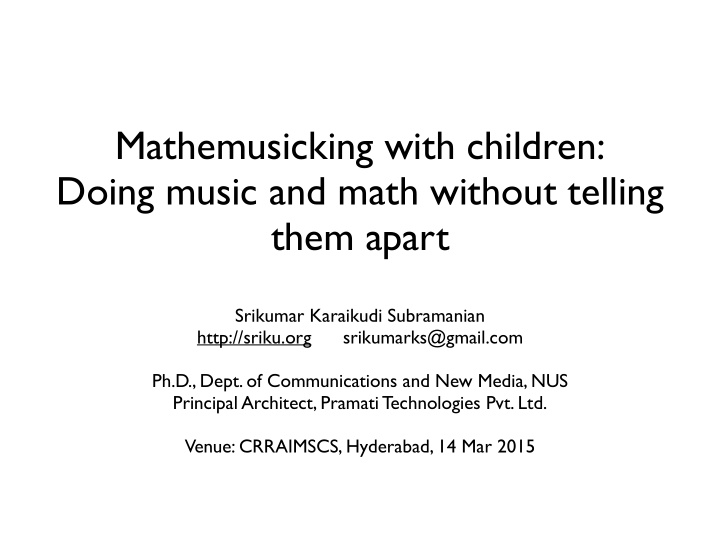



Mathemusicking with children: Doing music and math without telling them apart Srikumar Karaikudi Subramanian http://sriku.org srikumarks@gmail.com Ph.D., Dept. of Communications and New Media, NUS Principal Architect, Pramati Technologies Pvt. Ltd. Venue: CRRAIMSCS, Hyderabad, 14 Mar 2015
Overview • Introduction to “Mathemusicking” • Cognitive models and design • Summer 2014 workshop @ Brhaddhvani • Reactions of the children • Conclusion
Overview • Introduction to “Mathemusicking” • Cognitive models and design • Summer 2014 workshop @ Brhaddhvani • Reactions of the children • Conclusion
“Musicking” Music Activity (artifacts) (experience)
Musicking Bodies: Gesture and Voice in Hindustani Music by Matthew Rahaim
“Mathematicking” ? Maths Activity (artifacts) (experience)
Paul Lockhart’s “Lament” • “A mathematician, like a painter or poet, is a maker of patterns.” - G. H. Hardy • “The trouble is that math, like painting or poetry, is hard creative work” - P . L. • “I’m just playing. That’s what math is— wondering, playing, amusing yourself with your imagination.” - P . L.
Maths and Music ? Maths Music Artifacts or Activity?
Mathemusicking Maths (“ing”) Cognitive Music Science
Mathemusicking What is our natural state of playing with mathematical/musical ideas?
Overview • Introduction to “Mathemusicking” • Cognitive models and design • Summer 2014 workshop @ Brhaddhvani • Reactions of the children • Conclusion
Jean Piaget • Theory of cognitive development • “The great pioneer of constructivist theory of knowing” • Inspiration for the “Montessori method”
Seymour Papert • “Constructionism” • Inventor of “turtle graphics” and “Logo” • Book : “Mindstorms: Children, Computers, And Powerful Ideas"
Gary Drescher Applied constructivism, schema theory and bayesian inference to study concept formation in the “mind” of a robot in a simulated environment.
Embodied cognition "By using the term ‘embodied’ we mean to highlight two points: first that cognition depends upon the kinds of experience that come from having a body with various sensorimotor capacities, and second, that these individual sensorimotor capacities are themselves embedded in a more encompassing biological, psychological and cultural context.” - Rosch, Thompson and Varela in “The Embodied Mind”
Mathemusicking Maths Design in this space (“ing”) Cognitive Music Science
Brhaddhvani Director Dr. Karaikudi S. Subramanian with children, at the “melakarta and tala table”
Workshop concept • Introduce children to music composition. • Try out whether they’re able to work with “advanced” mathematics.
Means • Design activities for - • Rhythm composition • Melodic shapes • Intonation • Structuring • Tools for interactive exploration
Mathematical ideas • Modulo arithmetic • Permutations and combinations • Graph structures • Generative grammars
Rhythm composition
Rhythm composition
Rhythm composition
Rhythm realization
Melakarta system n N g G M P Ṡ n S D R g m d D r R sa ri ga ma pa da ni ṡ a
Melakarta system
Composing with Garage Band
“Mountain pattern”
Song writing
MIT Scratch Interactive exploration of ideas through simulation.
Interactive exploration
Interactive exploration
Interactive exploration
Interactive exploration
AABA song pattern
Reactions of the children
“This is music or maths? I’m confused.” Thejesh, after working with the rhythm composition kit.
“We made our own ragas.” Several children, on being asked what they did with the melakarta exploration kit.
“Ayya jolly!” When a group got their turn to work on their Scratch project.
“No!” From nearly everyone, when asked at 1:30pm whether they were hungry.
Summary • How can we engage children in maths and music so they enjoy it? • What possibilities exist for applying cognitive models to design such engagements? • Having escaped from the line, how much more fun can we have in the triangle?
Thank you
Recommend
More recommend